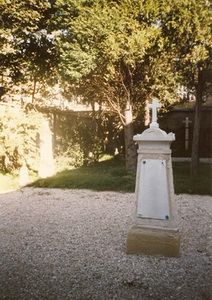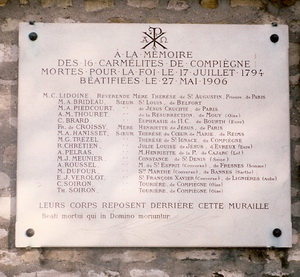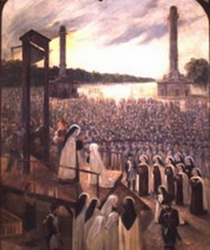Also known as the Compiègne Martyrs.
Beatified May 13th 1906. Feast Day July 17th
On July 17th 1794 during the French Revolution, these sixteen nuns died at the guillotine after having offered their lives for the Church and for France. At that time the revolutionary government had forbidden religious to live in community. Blessed Teresa of St. Augustine was their Prioress and it was she who suggested to the nuns that they might offer their lives for the Church and their country.
Blessed Teresa was born in the parish of St. Sulpice in Paris and baptised in that church. Her full name was Marie-Madeleine-Claudine Lidoine. Her mother was 41 when she was born and she was the only child of her parents. Madeleine’s father was employed by the Paris Observatory and her parents gave her a good education which developed her artistic and poetic gifts, but having spent their money on her education they did not have the means to provide her with a dowry when she wanted to enter Carmel.

The royal princess, Madame Louise, who had entered the Carmel of St. Denis and taken the name Sr. Teresa of St. Augustine, heard of Madeleine’s situation and asked to meet her. Convinced of her vocation she asked her nephew’s wife, the young Dauphine Marie Antoinette, to provide a dowry which she did willingly. Madeleine was able to enter the Carmel of Compiègne where she took the name of her patroness, Sr. Teresa of St. Augustine.
In 1786, when she was 34 Sr. Teresa of St. Augustine was elected prioress and she was re-elected in 1789. By that time she was already well aware of the precarious situation of religious in France. That January she had received the vows of a lay sister, Sr. St. Francis Xavier, the last novice to be professed in Compiègne before the ‘suspension’ of vows was introduced in October, this was followed immediately by the confiscation of Church property. Sr. Teresa stressed the risks this young novice was taking, giving her the opportunity to leave, even though she was much needed to help the two older lay sisters, one of whom was chronically sick. Sr. Xavier assured Mother Teresa that the Lord would take care of her and went ahead with her profession.
In August 1790 the Revolutionary Directors entered the Carmel to make the required inventory. They returned the next day with armed guards and proceeded to question each sister to see if any of them were being held against their will. Every one of them stated that she wished to remain a Carmelite and seven of them, including Sr. Teresa of St. Augustine said explicitly that they wished to live and die in their religious state.
In September 1792 the monastery was stripped of its furnishings and the nuns were ordered to dress in civilian clothing and leave the monastery. They were forbidden to live together but found lodgings in four apartments quite close to each other and were in constant communication, in fact one sister cooked for them all.

Soon after the sisters were expelled from their monastery, following the fall of the Christian Monarchy and the terrible September massacres, Sr. Teresa of St. Augustine proposed that they make an Act of Consecration, an act which would be recited daily by all the community, in which each one would offer herself entirely to God as a holocaust, that peace might be restored to France and especially to the French Church. Reaction to this suggestion varied but by November they had all grown into the idea, it was above all an offering of love for the church and their country. Sr. Teresa was convinced that love always triumphs.
The following June the nuns’ apartments were requisitioned and the community were imprisoned in the former Visitation Convent where to their surprise they found a community of English Benedictines who had been arrested as foreigners the previous September.
However the Carmelites’ stay was short; after three weeks they were ordered to leave for Paris to be tried by the Revolutionary Tribunal.

They were taken to the Conciergerie Prison. The search of their apartments had confirmed that they were still trying to maintain their religious life as a community, which was forbidden. It was also clear that they had monarchist sympathies and opposed the Revolution. They spent the Feast of Our Lady of Mount Carmel in prison and the next day they were taken to the Revolutionary Tribunal to be tried. The verdict was determined before the trial; of the 35 prisoners tried in the ‘Courtroom of Freedom’ that day 30 were condemned, including the sixteen Carmelites.
On their last journey from the prison to the guillotine the nuns sang Vespers, Compline and the Office for the Dead. As they entered the Place du Trône and were confronted with the sight of the guillotine high on the scaffold Sr. Teresa began the Te Deum, which was followed by Veni Creator Spiritus. The executioner, who had inherited the task against his wishes, was willing to give concessions; he allowed the nuns to finish their devotions and permitted Sr. Teresa to decide the order in which they would die. Sr. Constance, the novice of six years, who had been unable to make her profession because of the anti-religious laws, was at last able to pronounce her vows with the rest of the community. She was the first to die having knelt to receive the blessing of the prioress and kissed a tiny terracotta statuette of the Madonna and Child which Sr. Teresa was holding. Before mounting the scaffold she asked permission to die, to which the prioress replied ‘Go my daughter’. The whole community followed this same pattern. Finally Sr. Teresa stood alone. As she prepared to bring to completion the offering of her life for the Church and for France, she too kissed the little statue of the Virgin and Child and made the sign of the Cross. Then she hesitated wondering what to do it. A woman in the crowd came forward to take it from her, ensuring its preservation to this day in the restored Carmel of Compiègne. With Sr. Teresa’s execution the ‘Act of Consecration’ made by the community was consummated.
The sisters are buried in a common grave in the Picpus Cemetery, where their names are recorded on a plaque on the wall.


Sr. Teresa of St. Augustine’s God given strength of character sustained her community through the difficult days of imprisonment and trial and God rewarded their fidelity and their final sacrifice.
Ten days after their martyrdom Robespierre himself was executed and less than two months after their deaths the reign of Terror came to an end.


[All the artistic depictions of the martyrdom are idealised, in reality the nuns wore their habits and mantles but not their veils and Sr. Teresa, aware that any hair or clothing would be removed from their necks had adapted their toques, cutting them above their necks, to save them the humiliation of having them removed by the revolutionary officials]


